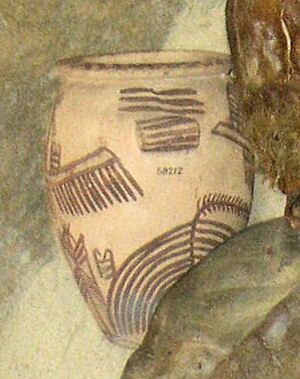Gebelein predynastic mummies facts for kids
Quick facts for kids Pre-dynastic Egyptian Man |
|
|---|---|
| Size | 1.63 metres (5 ft 4 in) |
| Created | Late Predynastic period c. 3400BC |
| Discovered | Gebelein |
| Present location | British Museum, London |
| Identification | EA 32751 |
The Gebelein predynastic mummies are six naturally preserved bodies from Ancient Egypt. They date back about 5,400 years ago, to a time before the famous pharaohs ruled. This period is called the Late Predynastic period. These mummies were the first complete bodies from this early time ever found.
An expert from the British Museum, E. A. Wallis Budge, found them in the late 1800s. They were buried in shallow sand graves near a place called Gebelein in the Egyptian desert. Budge found all six bodies in the same burial site. Two were identified as male and one as female. The others could not be identified by sex.
The bodies were given to the British Museum in 1900. They were found curled up, lying on their left sides, like a baby in the womb. The first body found (known as EA 32751) has been on display since 1901. People used to call him "Ginger" because of his red hair. However, this nickname is no longer used today due to new rules about respecting human remains.
Contents
How Were the Mummies Found?
Discovering Ancient Burials
In the late 1800s, many ancient sites in Egypt were being explored. Places like Abydos, Tukh, Hierakonpolis, and Gebelein were excavated. In 1892, an expert named Jacques de Morgan showed that pottery found at Abydos was older than the time of the pharaohs. This made many European archaeologists very interested in these early periods.
After official digs finished, local Egyptians often kept searching the sites for more ancient items. In 1895, E. A. Wallis Budge from the British Museum bought many items from locals. These included bowls, spearheads, and arrowheads from the predynastic period.
The Gebelein Discovery
In 1896, a local person from Gebelein told Budge about some mummies they had found. Budge went to see them and immediately knew they were from the predynastic period. He realized these were the first complete bodies from that time ever found.
Budge then started his own excavation. He found a total of six mummified bodies. They were buried in shallow sand graves at a place called Baḥr Bila Mâ, which means "Waterless River." This site was on the eastern slopes of the northernmost hill at Gebelein.
Natural Mummification in Sand
The only items found with the bodies were a pot with the female adult and small pieces of wicker, fur, and linen with the others. In the predynastic period, people were usually buried without clothes or loosely wrapped. When a body is covered in warm, dry sand, the water inside it quickly dries out. This naturally preserves the body.
This natural way of mummifying was common in early Egypt, long before people learned to mummify bodies artificially. This natural preservation might have made ancient Egyptians believe in life after death. It also could have started the tradition of leaving food and tools for the dead to use in the afterlife.
Burial Positions Over Time
All the Gebelein bodies were found in a similar curled position. They lay on their left sides with their knees pulled up towards their chin. Most bodies found from the predynastic period in Egypt are in this same position.
This side-lying position was common from the time these mummies were buried until the Middle Kingdom period. After that, people were buried on their backs. By the Fifth Dynasty, bodies were always laid out straight.
Where Can You See Them?
The British Museum bought the mummies in 1900. One male adult body, known as EA 32751, went on display in 1901. It was the first ancient mummified body that the public could see. It has been on continuous display in the same gallery since then, except for times when it needed care.
In 1987, this male body was temporarily removed for restoration. A female mummified body took its place. She was nicknamed "Gingerella," even though her hair was long and brown.
The male body, EA 32751, is displayed in the British Museum in Room 64, Case 15. It is shown in a reconstructed sand grave, just like how it was found. Although Budge mentioned finding "pots and flints" with the body, these items were not given to the museum. Instead, the display uses other ancient Egyptian grave goods from similar burials of that time.
These items include black-topped clay pots, which were common in the predynastic period. There are also plain pots and bowls from slightly later times. Other items like slate palettes, stone vessels, and flint knives are also shown. These would have been part of more important burials from the historical period.
Of the other five bodies, only the female adult, EA 32752, has been shown to the public. In 1997-1998, she traveled to Rome for an exhibition called Ancient Faces. In 2001, she went to Birmingham for the Egypt Revealed exhibition. Before this trip, she had some repairs. For example, a loose finger and a rib were reattached using special paper.
Images for kids




